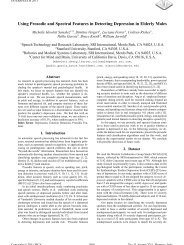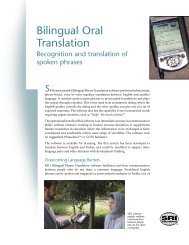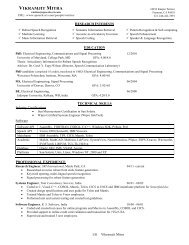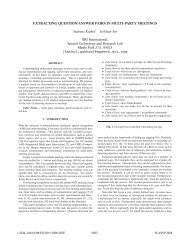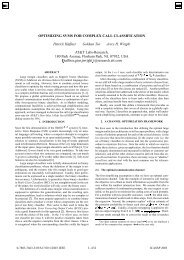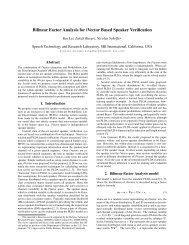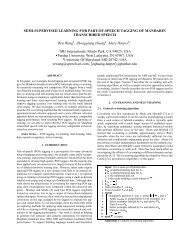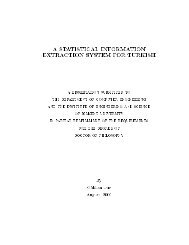eurasip2007-groupdel.. - SRI Speech Technology and Research ...
eurasip2007-groupdel.. - SRI Speech Technology and Research ...
eurasip2007-groupdel.. - SRI Speech Technology and Research ...
Create successful ePaper yourself
Turn your PDF publications into a flip-book with our unique Google optimized e-Paper software.
8 EURASIP Journal on Audio, <strong>Speech</strong>, <strong>and</strong> Music Processing<br />
to another. The shape of the filter is controlled by a constant<br />
which varies from 0 to 1, where 0 corresponds to triangular<br />
<strong>and</strong> 1 corresponds to rectangular. The filter bank energies<br />
are then computed by integrating the energy in each filter.<br />
A discrete cosine transform (DCT) is then used to convert<br />
the filter bank log energies to cepstral coefficients. Cepstral<br />
mean subtraction is always applied when working with noisy<br />
telephonespeech.Thefrontendparametersaretunedcarefully<br />
as in [43] for computing the MFCC so that the best<br />
performance is achieved. The LFCC are computed in a similar<br />
fashion except that the frequency warping is not done as<br />
in the computation of the MFCC. The velocity, acceleration,<br />
<strong>and</strong> the energy parameters are added for both the MFCC<br />
<strong>and</strong>LFCCinaconventionalmanner.Thespectralrootcompressed<br />
MFCC are computed as described in [44] <strong>and</strong> the energy<br />
root compressed MFCC as in [35]. The computation of<br />
the spectral root compressed MFCC is the same as the computation<br />
of the MFCC except that instead of taking a log of<br />
the FFT spectrum, we raise the FFT spectrum to a power γ<br />
where the value of γ rangesfrom0to2.Inthecomputation<br />
of the energy root compressed MFCC, instead of raising the<br />
FFT spectrum to the root value, the Mel frequency filter bank<br />
energies are compressed using the root value. In the energy<br />
root compressed case, the value of the root used for compression<br />
can range from 0 to 1. The normalized spectral root<br />
compressed MFCC is computed by normalizing the shorttime<br />
power spectrum with its cepstrally smoothed version,<br />
followed by root compression as in the case of the spectral<br />
root compressed MFCC. It is emphasized here that all the<br />
free parameters involved in the computation of all these features<br />
including the root value <strong>and</strong> the cepstral window length<br />
used in spectral smoothing have been tuned carefully so that<br />
they give the best performance <strong>and</strong> are not h<strong>and</strong>icapped in<br />
any way when they are compared with the MODGDF. The<br />
values of the spectral root <strong>and</strong> the energy root used in the<br />
experiments are 2/3 <strong>and</strong> 0.08, respectively. The velocity, acceleration<br />
<strong>and</strong> the energy parameters are augmented to both<br />
forms of the root compressed MFCC in a conventional manner.<br />
Note that all free parameters in all the aforementioned<br />
features have been tuned using line search on a validation<br />
data set selected from the particular database.<br />
8.2. Computation <strong>and</strong> tuning of free parameters<br />
for the MODGDF<br />
There are three free parameters lifter w , α, <strong>and</strong>γ involved in<br />
the computation of the MODGDF as discussed in Section 4.<br />
From the results of initial experiments on the databases described<br />
in Section 7, we fix the length of the lifter w to 8 although<br />
the performance remains nearly the same for lengths<br />
from 4 to 9. Any value greater than 9 brings down the performance.<br />
Having fixed the length of the lifter w , we then<br />
fix the values of α <strong>and</strong> γ. In order to estimate the values of<br />
α <strong>and</strong> γ, an extensive optimization was carried out for the<br />
SPINE database [45] for phoneme recognition. To ensure<br />
that the optimized parameters were not specific to a particular<br />
database, we collected the sets of parameters that gave<br />
best performance on the SPINE database <strong>and</strong> tested them on<br />
Table 1: Series of experiments conducted on various databases with<br />
the MODGDF.<br />
Experiments conducted on the various databases<br />
N c = 10, 12, 13, 16<br />
γ = 0.1 1.0 in increments of 0.1<br />
α = 0.1 1.0 in increments of 0.1<br />
lifter w = 4, 6, 9, 10, 12<br />
Table 2: Best front end for the MODGDF across all databases.<br />
γ α lifter w N c<br />
0.9 0.4 8 13<br />
other databases like the DBIL database (for syllable recognition),<br />
TIMIT, NTIMIT (for speaker identification), <strong>and</strong> the<br />
OGI MLTS database (for language identification). The values<br />
of the parameters that gave the best performance across<br />
all databases <strong>and</strong> across all tasks were finally chosen for the<br />
experiments. The optimization technique uses successive line<br />
searches. For each iteration, α is held constant <strong>and</strong> γ is varied<br />
from 0 to 1 in increments of 0.1 (line search) <strong>and</strong> the<br />
recognition rate is noted for the three tasks on the aforementioned<br />
databases. The value of γ that maximizes the recognition<br />
rate is fixed as the optimal value. A similar line search<br />
is performed on α (varying it from 0 to 1 in increments of<br />
0.1) keeping γ fixed. Finally, the set of values of α <strong>and</strong> γ that<br />
give the lowest error rate across the three tasks is retained.<br />
The series of experiments conducted to estimate the optimal<br />
values for lifter w , α, <strong>and</strong>γ using line search are summarized<br />
in Table 1. Based on the results of such line searches,<br />
the best front end for the MODGDF across all tasks is listed<br />
in Table 2.<br />
8.3. Extraction of joint features before<br />
the acoustic model<br />
The following method is used to derive joint features by combining<br />
features before the acoustic model.<br />
(i) Compute 13-dimensional MODGDF <strong>and</strong> the MFCC<br />
streams appended with velocity, acceleration, <strong>and</strong> energy<br />
parameters.<br />
(ii) Use feature stream combination to append the 42-<br />
dimensional MODGDF stream to the 42-dimensional<br />
MFCC stream to derive an 84-dimensional joint feature<br />
stream.<br />
Henceforth, we use the subscript bm for joint features thus<br />
derived.<br />
8.4. Likelihood combination after the acoustic model<br />
The following method is used to do a likelihood combination<br />
after the acoustic model.<br />
(i) Compute 13-dimensional MODGDF <strong>and</strong> the MFCC<br />
streams appended with velocity, acceleration, <strong>and</strong> energy<br />
parameters.



